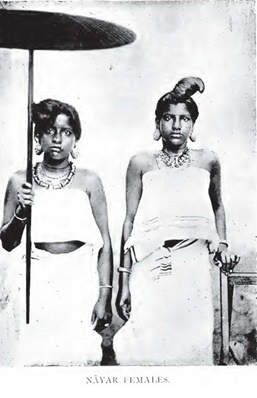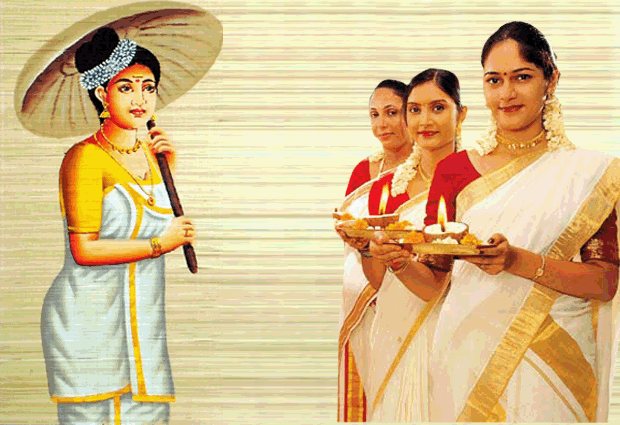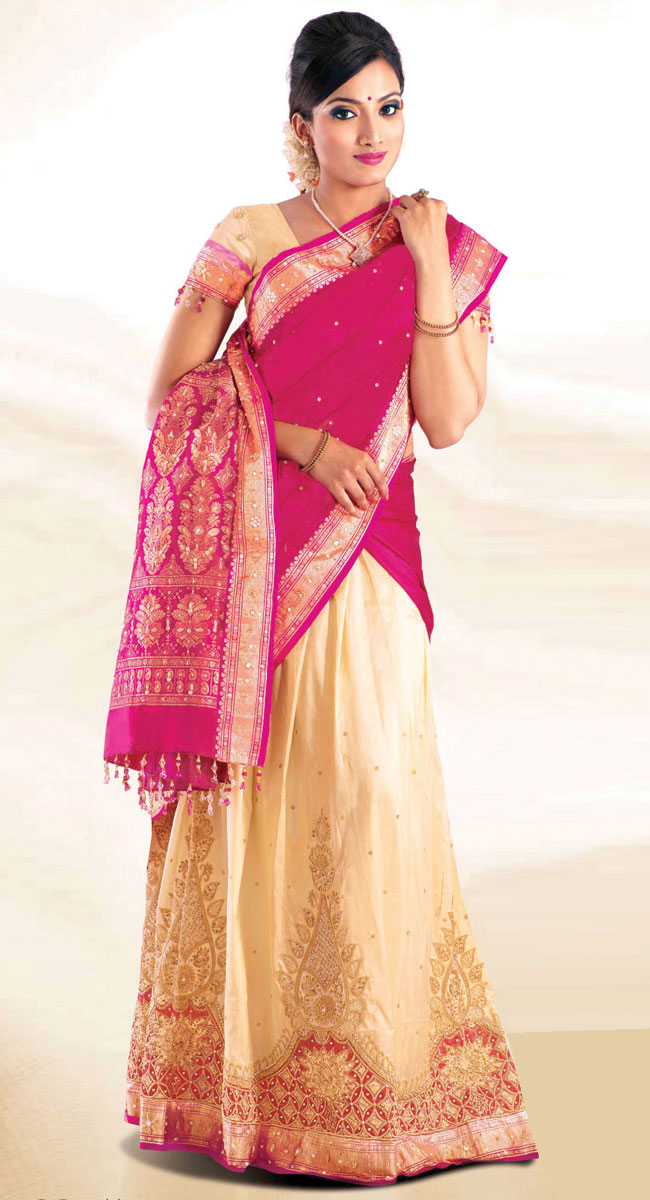India is a land of varied geography. But geography in India is not just about physical features; it is sacred. The geography of a particular place is intimately intertwined with its culture and its people and people mould their lives according to the geography they are in. Living in a certain geography in India means to be in harmony with it, to enhance it, and to make it more beautiful. I dwell on the subject of aesthetics here with the example of dress and particularly female dress.
Let us take the two examples of Rajasthan (desert landscape) and Kerala (lush vegetation). The women of Rajasthan wear flowing lehengas with cholis and chunaris which are in bright shades of yellow, red, blue, green and so on. These bright colours do enhance the beauty of the stark, sandy, desert landscape and are a feast for the eyes. On the other hand, the state of Kerala, a tiny strip on the west coast of India is a riot of green, blue and brown because she is richly endowed with lush vegetation, is by the sea, and has a high hill range protecting her. When she is endowed with so much natural beauty, people don’t need to add more colour to add to her beauty; which is why the predominant colour of the dress that Keralites wear is white or off white, with some minor embellishments. It is so apt, for this simplicity just adds elegance and a look of purity/freshness to the greens, blues and browns of the richly endowed land.
So, my focus here is only on one of the off white garments that Keralites wear. I refer to the set mundu that is the most simple attire of a lady in Kerala but which has evolved into one of the most understated, lovely, fashion statements at least in sections of Malayali society today.
The set mundu is essentially a two piece clothing worn with a blouse which has evolved to be worn like a saree in the present day. However, the origins of the garment were certainly not in the present form.
The Evolution of the Set Mundu – A little bit of history
Kerala is a very hot and humid place and I contend that its society was not overly concerned with issues of clothing and fashion. Moreover, the Western Ghats bordering Kerala act as a natural barrier and cocoon the land from overland influences. Hence influences from outside reached Kerala only slowly except if those influences came via the sea route. The preferred dress was to wear a simple white/off white cotton cloth called mundu which was tied at the waist and fell to the ankles or below the knees. A light piece of cloth across the breast and over the shoulders was called the upper cloth or melmundu.
Slowly, the present day blouse that most Indian women wear with a saree began to gain popularity in Kerala.
And the melmundu began to be worn over the blouse in the traditional way.
The Weaver Story
As I was researching for this subject I came across information about the creators of this garment. There are I think principally 3 regions where the weaver community who create this garment live. One is Balaramapuram near Thiruvananthapuram, another is Kuthampully in Thrissur district and the third is Chendamangalam near Ernakulam. The weavers In Kuthampully and Balaramapuram trace their origins to Karnataka and Tamil Nadu respectively. Kuthampully weavers say they are from the Devanga community in the erstwhile Mysore state who left their ancestral land during the period of Turkic rule which was hostile. They settled in Kuthampully, a village on the banks of the Bharatapuzha (Nila) and became the weavers for the Royal family of Kochi (Cochin). The Balaramapuram weavers trace their origins to the Shaliyar community of Tamil Nadu who were again brought to Thiruvananthapuram by the Travancore kings to be weavers for the Royal family.
How did the Set Mundu evolve to its present avatar?
With the coming of the weavers from Karnataka and Tamil Nadu, a part of their culture would have come to Kerala. Both in Karnataka and Tamil Nadu, there is a culture of little girls wearing chattai pavadai /Langa (two piece garment with a long pleated ankle length skirt from waist down and a waist length blouse for the top).
This garment metamorphoses into dhavani-pavadai as the girls turn into their later teen years. A dhavani-pavadai is a three piece garment. Like in chattai pavadai, you have the ankle length long pleated skirt, the waist length blouse of the childhood years turns into a blouse that is used with a saree. Over this ensemble is worn the dhavani which is a long piece of cloth which is pleated and goes across the left shoulder with the other end tucked into the pavadai. Essentially it looks like the pallu of a regular saree. This culture was probably brought into cocooned Kerala by the weavers who were anyway familiar with these clothes.
Now, once the girl got married, she graduated from the dhavani phase into the mundu blouse phase. That’s probably when the melmundu began to be redesigned like a dhavani with pleats going across the bosom and over the left shoulder with the other end end tucked into the mundu. This gave the whole ensemble a saree like look.
Generally, the set mundu is quite simple when it comes to embellishments. For the larger part, it is plain off white, cotton cloth both in the mundu and the neriyathu (melmundu) with just the borders of the cloth and the two ends being either woven with jari/gold thread (kasavu) bands or with bands that are of different colour thread. The garment is elegant, understated and extremely comfortable to wear. And most of all, it gives a pristine, fresh look when contrasted with the lush vegetation. It is everyday wear for older women and it is really a pleasure to see elder women start each day wearing a fresh, starched set mundu after a bath. The look of freshness is enough to wake one up and be thankful for the new day!
This garment while it was regularly used by the older generation, generally by women over 45-50 since it imparted an air of maturity and understated beauty, it has now been adopted by youngsters too as a style statement. In the Namboodiri community, this garment has become the rage in recent years with it being adopted as the standard dress code for occasions. For occasions such as a wedding, it has now become the norm to order set mundus in bulk. They are ordered like a uniform with the groom and bride’s side being distinguished by the respective uniform set mundus.
The set mundu is a definite requirement when doing the traditional folk dance of Kerala for women, called the Kaikottikkali or Thiruvathirakkali. It is also worn on festive occasions like Onam , Vishu and Thiruvathira.
Problems facing this sector
As everywhere else, this is purely the handloom sector and facing an existential crisis. As I did my research, I chanced upon news item after news item which spoke of the penury of these handloom weavers. All the three places Kuthampully, Balaramapuram and Chendamangalam have been given intellectual property rights through the Geographical Indication Act. But even this has not prevented the decline in their means of livelihood.
Their profession is not seen as being respectable and the younger generation is clearly not interested in taking up the trade in a 100% literate state. Many of the weavers themselves do not encourage their children to take up the profession. They push them towards professional courses so that they have better prospects in the ‘marriage market’[2]. This is in Kuthampully.
I happened to chance upon a blog by a young boy who is from Kuthampully but not into his ancestral trade anymore. From the tenor of the post, I felt the boy is quite apologetic about his ancestors’ profession and does not look upon it with pride. He of course seems to be employed in an IT firm in some other state. He seems to feel his village is a relic of some bygone era and one senses that he feels he has escaped the drudgery. Irony is that education has meant becoming disassociated from your past. Education has meant devaluation of a skill and its ability to become your livelihood. Weavers face many hardships too because earnings are low, peoples’ choices have evolved and hence their market has shrunk, and they are unable to repay debts as institutional funding is not easily available to them. However, the few who remain in the profession say that it “gives me immense pleasure to see the finished product”[3]. I can only agree with her that that is the unalloyed joy one gets when one creates something.
The Road Ahead
While the market for set mundus will not die out for another generation maybe, its long term prospects are certainly in Intensive Care as the younger generation moves on to trendy western clothes and salwar kameez (which incidentally was a rarity in Kerala even in the 90s). I sincerely hope something is done to restore this extremely humble and simple yet elegant garment regain place of pride. For nothing brings more beauty to the lush landscape of “God’s Own Country” than a beautiful Malayali woman donning this fresh and simple dress with the simple accessories that go with it. Nothing rivals it to exude that quiet elegance which contrasts with the riotous colours of nature.
References:
- http://www.newindianexpress.com/states/kerala/A-Life-without-Zari-for-Kuthampullys-Weavers/2014/11/10/article2516445.ece
- http://www.newindianexpress.com/cities/kochi/A-story-of-the-struggle-for-survival/2013/10/22/article1848198.ece
- https://myshadowflowers.wordpress.com/2012/09/07/kuthampully-the-village-of-weavers/
- The Spirituality of Basic Ecclesial Communities in the Socio-religious context of Trivandrum/Kerala, pg. 109
- http://pazhayathu.blogspot.in/2012/02/kerala-dress-1500-till-now.html
- http://www.mkhandlooms.com/about_us
- http://www.ashahandlooms.com/history.php
- http://www.kaithary.com/about-us
Disclaimer: This article represents the opinions of the Author, and should not be considered a reflection of the views of the Andhra Cultural Portal. The Author is responsible for ensuring the factual veracity of the content, herein.







![[Reprint Post] On Dharma](https://andhraportal.org/wp-content/uploads/2013/08/Dharmachakra-150x150.png)



A wonderful piece of study. Appreciate the bloggers research into the undercurrents for the decline of this elegant dress of a Malayali. The observation” Education has meant devaluation of a skill and its ability to earn a livelihood” is absolutely right and perhaps, a sad prelude to yet another traditional form of craftsmanship fading into oblivion, replaced by pompous aliens ways of dressing and thinking.